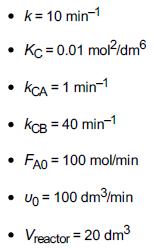The first-order, gas-phase, reversible reaction AB+2C is taking place in a membrane reactor. Pure A enters the
Question:
The first-order, gas-phase, reversible reaction A←→B+2C is taking place in a membrane reactor. Pure A enters the reactor, and B diffuses out through the membrane. Unfortunately, a small amount of the reactant A also diffuses through the membrane.
a. Plot and analyze the flow rates of A, B, and C and the conversion X down the reactor, as well as the flow rates of A and B through the membrane.
b. Next, compare the conversion profiles in a conventional PFR with those of a membrane reactor from part (a). What generalizations can you make?
c. Would the conversion of A be greater or smaller if C were diffusing out instead of B?
Additional information:
Fantastic news! We've Found the answer you've been seeking!
Step by Step Answer:
Related Book For 

Question Posted:





